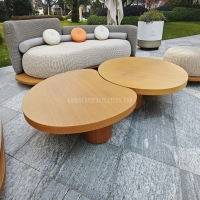Welcome to the website for landscape facilities products and knowledge.
How does the table’s design account for space efficiency in small or crowded environments?
In today's urban landscapes where square footage comes at a premium, table design has evolved to address spatial constraints with remarkable ingenuity. The fundamental challenge for furniture designers lies in creating pieces that serve multiple purposes while occupying minimal footprint. This has led to revolutionary approaches in how we perceive and utilize tables in confined spaces.
Foldable and collapsible designs represent one of the most effective solutions for space-constrained environments. These innovative tables feature hinges, sliding mechanisms, or telescoping legs that allow them to be compactly stored when not in use. Wall-mounted versions take this concept further by completely eliminating floor space requirements, folding flat against walls like artistic installations until needed. The magic of these designs lies in their transformation capability - what appears as a simple wall panel can unfold into a full-sized dining surface capable of seating multiple guests.
Multi-functional tables demonstrate another layer of spatial intelligence through integrated design philosophy. These pieces combine table surfaces with storage compartments, seating arrangements, or even convertible features that transform into completely different furniture items. A coffee table might rise to dining height, a desk might incorporate bookshelves, or a console table could extend to accommodate dinner parties. This approach reduces the need for multiple furniture pieces, dramatically decreasing the spatial footprint while increasing utility.
Designers also employ visual tricks to enhance spatial perception in crowded settings. Tables with glass tops create an illusion of openness, while slender legs and open bases maintain sightlines, making rooms feel less congested. The strategic use of light colors and reflective materials further amplifies this effect, contributing to an overall sense of airiness despite physical limitations.
Material selection plays a crucial role in space-efficient table design. Lightweight yet durable materials like aluminum, engineered wood, and advanced composites enable slimmer profiles without compromising stability. This material innovation allows for designs that feel substantial enough for practical use while maintaining elegant, space-conscious proportions.
The integration of technology represents the latest frontier in space-optimized table design. Modern solutions include tables with built-in wireless charging, cable management systems, and even retractable power outlets. These features eliminate the need for additional furniture or accessories that would otherwise consume precious space, creating cleaner, more organized environments.
Ultimately, effective table design for small spaces represents a harmonious balance between form and function. It's not merely about making tables smaller, but about reimagining their purpose and interaction with surrounding space. Through clever engineering, thoughtful material selection, and multi-purpose integration, today's table designs prove that limited space doesn't mean compromising on style, comfort, or functionality.
Related search:

Recommendation
Elliptical metal outdoor table with nested design, resembling wood grain, round table